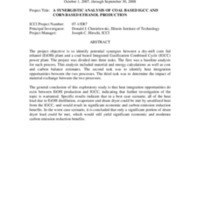A SYNERGISTIC ANALYSIS OF COAL BASED IGCC AND CORN BASED ETHANOL PRODUCTION
Title
A SYNERGISTIC ANALYSIS OF COAL BASED IGCC AND CORN BASED ETHANOL PRODUCTION
ICCI Project ID
07-1/ER7
Investigator
Chmielewski
Institution
Illinois Institute of Technology
ICCI Abstract
The project objective is to identify potential synergies that may result from the collocation of a dry-mill corn ethanol plant and an Integrated Gasification Combined Cycle (IGCC) electric power plant. The underlying premise is that fermentation based ethanol production requires significant heat input. This heat is used to drive the ethanol purification process as well as the drying of co-products. However, the quality of heat required for these two separations is fairly low. As with most power cycles, the IGCC process utilizes large quantities of high quality heat, but then must also expel similarly large quantities of low quality heat. Thus, the thesis of the project is to determine if the IGCC process has sufficient heat available at sufficient quality to meet the needs of the ethanol plant.
To facilitate the analysis, two representative processes were selected. The first is a corn fed dry mill ethanol plant that produces 100 million gal/yr of ethanol (EtOH), which can be classified as a medium-to-large sized EtOH plant. Regarding IGCC, our calculations were based on the size and configuration of the Wabash River demonstration plant, which can be classified as a small-to-medium sized power plant (265MWe).
The results of the baseline analysis, assuming each plant operates in isolation, are that the EtOH plant requires 126 MW of hot utility which corresponds to nearly 92% of the plant profit and 26% of the CO2e emissions from EtOH production. On the IGCC side, it was found that over 200 MW of intermediate quality heat may be available.
Heat integration analysis between the two plants concluded that the EtOH plant may be able to receive the entire 126 MW of heating load from the IGCC. The heat exchanger purchase cost for this new configuration was calculated as $173,290 (in 2006 dollars). The resulting increase in EtOH plant profit was calculated as $39.4 MM/yr (an increase of 92% for the EtOH plant and 23% for the EtOH/IGCC complex). Reductions in CO2e emissions were also substantial (26% for the EtOH plant and 8.5% for the complex). An additional analysis of material exchange between the processes concluded that using EtOH co-products as feed to the gasifier is far from economical and provides only marginal reductions in CO2e emissions.
Based on this case study for a specific pair of plant configurations, it is concluded that heat integration opportunities between IGCC and EtOH production are possible and may yield meaningful profit improvements and CO2e emission reductions. This initial evidence, based on two arbitrary plant designs, suggests that operating condition modifications to either or both plants may yield even greater integration opportunities, and gives credence to future efforts aimed at achieving this goal.
To facilitate the analysis, two representative processes were selected. The first is a corn fed dry mill ethanol plant that produces 100 million gal/yr of ethanol (EtOH), which can be classified as a medium-to-large sized EtOH plant. Regarding IGCC, our calculations were based on the size and configuration of the Wabash River demonstration plant, which can be classified as a small-to-medium sized power plant (265MWe).
The results of the baseline analysis, assuming each plant operates in isolation, are that the EtOH plant requires 126 MW of hot utility which corresponds to nearly 92% of the plant profit and 26% of the CO2e emissions from EtOH production. On the IGCC side, it was found that over 200 MW of intermediate quality heat may be available.
Heat integration analysis between the two plants concluded that the EtOH plant may be able to receive the entire 126 MW of heating load from the IGCC. The heat exchanger purchase cost for this new configuration was calculated as $173,290 (in 2006 dollars). The resulting increase in EtOH plant profit was calculated as $39.4 MM/yr (an increase of 92% for the EtOH plant and 23% for the EtOH/IGCC complex). Reductions in CO2e emissions were also substantial (26% for the EtOH plant and 8.5% for the complex). An additional analysis of material exchange between the processes concluded that using EtOH co-products as feed to the gasifier is far from economical and provides only marginal reductions in CO2e emissions.
Based on this case study for a specific pair of plant configurations, it is concluded that heat integration opportunities between IGCC and EtOH production are possible and may yield meaningful profit improvements and CO2e emission reductions. This initial evidence, based on two arbitrary plant designs, suggests that operating condition modifications to either or both plants may yield even greater integration opportunities, and gives credence to future efforts aimed at achieving this goal.
Start Date
10/1/2007
End Date
9/30/2008
Year Funded
2007
Collection
Citation
“A SYNERGISTIC ANALYSIS OF COAL BASED IGCC AND CORN BASED ETHANOL PRODUCTION,” ICCI Reports, accessed May 20, 2024, https://isgswikis.web.illinois.edu/icci_reports/items/show/22.
